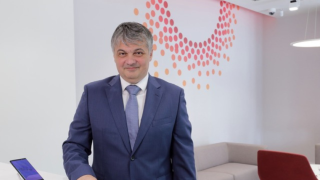FOCUS is a term that is very much embedded into Aqua Comms’ company strategy. For those who do not know, can you explain what FOCUS means and its place in the company roadmap?
FOCUS is at Aqua Comms’ core: Fibre Optic Cables Under the Sea. This is our area of expertise – from design, to build, to operating and to delivering the best-in-class service for our customers.
As a result, we don’t look to extend our network footprint beyond the core subsea network infrastructure. We focus on subsea cables, to deliver the optimal service performance across these assets in the same way that there are those that excel at terrestrial networks, with whom we partner, not compete.
We operate this approach in the Atlantic market today, and feel it is the right approach for the industry to support the predicted exponential growth combined with the ever-increasing need for efficiency. Our expectation is that it can be replicated in other markets around the world.
Aqua Comms focuses specifically on the subsea layer of the telecoms industry. How is this focus a strength and key differentiator for the company?
By only operating subsea assets, we believe that we deliver the best-in-class service. This includes an industry-leading provisioning time where we can deliver in as little as 72 hours – and we typically deliver quicker than a cross connect. This is a step change in the industry and supports our positioning as the ideal partner to work with – outsource your Atlantic network needs to us and we remove any headache of delivering that part of the solution.
It also means that our entire operations, from sales to service delivery to ongoing operational support etc, is structured on delivering subsea capacity services only, and we can therefore run this efficiently and with customers at the forefront of our minds throughout every member of the team in every function. We are a relatively young company and this has allowed us to create the efficient scalable systems and processes with no legacy issues to overcome.
Further, we only serve the wholesale market as a carriers’ carrier. We serve this market at the Transport layer only. This means we can operate as an Independent Infrastructure Partner (IIP) in our industry.
The combination of the above means we see ourselves as the only operator in the Atlantic that can serve the wholesale market in a neutral way where we don’t compete with our customers in Enterprise, in IP, in their domestic markets etc.
How is the retirement of legacy systems driving the need for increasing route diversity?
Industry analysts such as Telegeography have recently shown how the majority of legacy systems on the Atlantic (built between 1998 and 2003) landed in the UK, typically Cornwall and the New York City area. One of the key changes that the large content and OTT players brought to the subsea market is the change in network design requirements.
Not only have we seen the bandwidth capability of the new subsea cables increase multiple times compared to the legacy cables, we have seen the need to add diversity to the traditional routes. If you look forward only a couple of years, the new Atlantic cables land with significant geographical diversity on both sides of the Ocean.
This includes AEC-2, Aqua Comms’ share of the Havfrue cable where we are connecting NJFX in Wall, New Jersey to both Denmark and Ireland.
How is the development of the North Atlantic Loop meeting this need for added route diversity as well as growing capacity demands?
The North Atlantic Loop supports both new and old ensuring that traditional routes into and out of New York are supported as well as offering diversity through a new landing in New Jersey (NJFX). On the European side, Aqua Comms is building 3 new cables this year (AEC-2, CC-2 and NSC) to create network resilience between the US, Ireland, the UK and Scandinavia.
These new cables combine with existing new assets (AEC-1 and CC-1) to not only support diversity but scale as all are built with base 100G coherent technology.
These cables are further enhanced by partnering with key data centre partners in Interxion (London, Dublin, Copenhagen), NJFX (New Jersey), 1025Connect (Long Island) and Stellium (UK).
As one of the key subsea players in Northern Europe, we are seeing an increasing interest in the region from a subsea and data standpoint. What makes the Nordic region ideal for subsea cable projects from Aqua Comms perspective?
The Nordics has seen an explosion of hyperscale data centres supported by the availability of low-cost and renewable energy. This has driven awareness of the opportunity and further investment into the region.
Combined with this, AEC-2 and NSC will bring much needed new and modern subsea cable connectivity to the region. TAT-14 is rumoured to be decommissioned by the end of 2020 and therefore AEC-2 and NSC will be RFS at the right time to support this and the continuing investment in the region.
Last time we spoke, you mentioned 10 cable landings for 2019 and potential expansion to other European markets. Can you update us on this plan; is this still the target for Aqua Comms in 2019?
I’m pleased to say that we are on track for completing the 10 landings this year to complete the 3 new cable systems I mentioned above. Andy Hudson, our chief network officer, and his team are enjoying a busy year!, working away diligently to deliver these, to create the North Atlantic Loop.
Regarding further European expansion in 2019 itself, we are not currently looking at building any new subsea cables but there are plans being looked at beyond that.
Our focus has been to expand our European reach through our partnerships with terrestrial network providers as mentioned above. This is to remain aligned with our strategy of being best-in-class in subsea transport services and ensuring we responsibly reach core markets for our customer base through best-in-class terrestrial network operators.





